Experimental Design and Optimization of Triclosan and 2.8-Diclorodibenzeno-p-dioxina Degradation by the Fe/Nb2O5/UV System
Abstract
1. Introduction
2. Results and Discussion
2.1. Catalysts Characterization
2.1.1. Pore Properties (BET Method)
2.1.2. X-ray Diffraction (XRD)
2.1.3. Photoacoustic Spectroscopy (PAS)
2.1.4. Scanning Electron Microscopy (SEM/EDS)
2.2. Photocatalytic Reaction
2.2.1. Catalyst Influence
2.2.2. pH Influence and Mass Catalitic
2.2.3. Adsorption, Photolysis, and Photo Catalyst Tests
2.2.4. Photo Stability
2.3. Experimental Design and Optimization
3. Materials and Methods
3.1. Fe/Nb2O5 Immobilized Synthesis
3.2. Characterization
3.3. Photocatalytic Tests
3.4. Optimization of Experimental Parameters
4. Conclusions
Author Contributions
Acknowledgments
Conflicts of Interest
References
- Bedoux, G.; Roig, B.; Thomas, O.; Dupont, V.; Le Bot, B. Occurrence and toxicity of antimicrobial triclosan and by-products in the environment. Environ. Sci. Pollut. Res. 2012, 19, 1044–1065. [Google Scholar] [CrossRef]
- Reiss, R.; Mackay, N.; Habig, C.; Griffin, J. An ecological risk assessment for triclosan in lotic systems following discharge from wastewater treatment plants in the United States. Environ. Toxicol. Chem. 2002, 21, 2483–2492. [Google Scholar] [CrossRef]
- Singer, H.; Müller, S.; Tixier, C.; Pillonel, L. Triclosan: Occurrence and Fate of a Widely Used Biocide in the Aquatic Environment: Field Measurements in Wastewater Treatment Plants, Surface Waters, and Lake Sediments. Environ. Sci. Technol. 2002, 36, 4998–5004. [Google Scholar] [CrossRef] [PubMed]
- Wang, J.L.; XU, L.J. Advanced oxidation processes for wastewater treatment: formation of hydroxyl radical and application. Crit. Rev. Environ. Sci. Technol. 2012, 42, 251–325. [Google Scholar] [CrossRef]
- Niu, J.; Dai, Y.; Yin, L.; Shang, J.; Crittenden, J.C. Photocatalytic reduction of triclosan on Au-Cu2O nanowire arrays as plasmonic photoatalysts under visible light irradiation. Phys. Chem. Chem. Phys. 2015, 17, 17421–17428. [Google Scholar] [CrossRef] [PubMed]
- Buth, J.M.; Steen, P.O.; Sueper, C.; Blumentritt, D.; Vikesland, P.J.; Arnold, W.A.; McNeill, K. Dioxin Photoproducts of Triclosan and Its Chlorinated Derivatives in Sediment Cores. Environ. Sci. Technol. 2010, 44, 4545–4551. [Google Scholar] [CrossRef]
- UNEP—United Nations Environment Programme. Persistent Organic Pollutants. 2013. Available online: http://www.chem.unep.ch/pops/ (accessed on 22 January 2018).
- Chen, J.; Huang, Y.; Li, G.; An, T.; Hu, Y.; Li, Y. VOCs elimination and health risk reduction in e-waste dismantling workshop using integrated techniques of electrostatic precipitation with advanced oxidation technologies. J. Hazard. Mater. 2016, 302, 395–403. [Google Scholar] [CrossRef] [PubMed]
- Zeng, Z.-Q.; Wang, J.-F.; Li, Z.-H.; Sun, B.-C.; Shao, L.; Li, W.-J.; Zou, H.-K. The Advanced Oxidation Process of Phenol Solution by O3/H2O2in a Rotating Packed Bed. Ozone Sci. Eng. 2013, 35, 101–108. [Google Scholar] [CrossRef]
- Abdullah, A.M.; Al-Thani, N.J.; Tawbi, K.; Al-Kandari, H. Carbon/nitrogen-doped TiO2: New synthesis route, characterization and application for phenol degradation. Arab. J. Chem. 2016, 9, 229–237. [Google Scholar] [CrossRef]
- Pelaez, M.; Nolan, N.T.; Pillai, S.C.; Seery, M.K.; Falaras, P.; Kontos, A.G. A review on the visible light active titanium dioxide photocatalysts for environmental applications. Appl. Catal. B Environ. 2012, 125, 331–349. [Google Scholar] [CrossRef]
- Espino-Estévez, M.R.; Fernández-Rodríguez, C.; González-Díaz, O.M. Effect of TiO2–Pd and TiO2–Ag on the photocatalytic oxidation of diclofenac, isoproturon and phenol. Chem. Eng. J. 2016, 298, 82–95. [Google Scholar] [CrossRef]
- Léonard, G.L.; Pàez, C.A.; Ramírez, A.E.; Mahy, J.G.; Heinrichs, B. Interactions between Zn2+ or ZnO with TiO2 to produce an efficient photocatalytic, superhydrophilic and aesthetic glass. J. Photochem. Photobiol. A Chem. 2018, 350, 32–43. [Google Scholar] [CrossRef]
- Yan, J.; Wu, G.; Guan, N.; Li, L. Nb2O5/TiO2 heterojunctions: Synthesis strategy and photocatalytic activity. Appl. Catal. B 2014, 152–153, 280–288. [Google Scholar] [CrossRef]
- Kalan, R.E.; Yaparatne, S.; Amirbahman, A.; Tripp, C.P. P25 titanium dioxide coated magnetic particles: Preparation, characterization and photocatalytic activity. Appl. Catal. B 2016, 187, 249–258. [Google Scholar] [CrossRef]
- Castro, D.C. Síntese de Nb2O5 mesoporo para aplicação em fotocatálise heterogênea. Master’s Degree, Universidade Federal de Mato Grosso do Sul, Campo Grande, MS, Brazil, 2014. [Google Scholar]
- Zhao, Y.; Zhou, X.; Ye, L.; Chi Edman Tsang, S. Nanostructured Nb2O5 catalysts. Nano Rev. 2012, 3, 17631. [Google Scholar] [CrossRef]
- Dong, Y.; Tang, D.; Li, C. Photocatalytic oxidation of methyl orange in water phase by immobilized TiO2-carbon nanotube nanocomposite photocatalyst. Appl. Surf. Sci. 2014, 296, 1–7. [Google Scholar] [CrossRef]
- Katsaros, G.; Stergiopoulos, T.; Arabatzis, I.; Papadokostaki, K.; Falaras, P. A solvent-free composite polymer/inorganic oxide electrolyte for high efficiency solid-state dye-sensitized solar cells. J. Photochem. Photobiol. 2002, 149, 191–198. [Google Scholar] [CrossRef]
- Sakkas, V.; Arabatzis, I.; Konstantinou, I.; Dimou, A.; Albanis, T.; Falaras, P. Metolachlor photocatalytic degradation using TiO2 photocatalysts. Appl. Catal. B Envioron. 2004, 49, 195–205. [Google Scholar] [CrossRef]
- Santos, L.M.; Machado, W.A.; França, M.D.; Borges, K.A.; Paniago, R.M.; Patrocinio, A.O.T.; Machado, A.E.H. Structural characterization of Ag-doped TiO2 with enhanced photocatalytic activity. RSC Adv. 2015, 5, 103752–103759. [Google Scholar] [CrossRef]
- Arcanjo, G.S.; Mounteer, A.H.; Bellato, C.R.; da Silva, L.M.M.; Brant Dias, S.H.; da Silva, P.R. Heterogeneous photocatalysis using TiO2 modified with hydrotalcite and iron oxide under UV–visible irradiation for color and toxicity reduction in secondary textile mill effluent. J. Environ. Manage. 2018, 211, 154–163. [Google Scholar] [CrossRef]
- Yadav, H.M.; Otari, S.V.; Koli, V.B.; Mali, S.S.; Hong, C.K.; Pawar, S.H.; Delekar, S.D. Preparation and characterization of copper-doped anatase TiO2 nanoparticles with visible light photocatalytic antibacterial activity. J. Photochem. Photobiol. 2014, 280, 32–38. [Google Scholar] [CrossRef]
- Fontana, K.B.; Chaves, E.S.; Kosera, V.S.; Lenzi, G.G. Barium removal by photocatalytic process: An alternative for water treatment. J. Water Process Eng. 2018, 22, 163–171. [Google Scholar] [CrossRef]
- Nakajima, K.; Baba, Y.; Noma, R.; Kitano, M.N.; Kondo, J.; Hayashi, S.; Hara, M. Nb2O5·nH2O as a Heterogeneous Catalyst with Water-Tolerant Lewis Acid Sites. J. Am. Chem. Soc. 2011, 133, 4224–4227. [Google Scholar] [CrossRef]
- Morais, L.A.; Adán, C.; Araujo, A.S.; Guedes, A.P.M.A.; Marugán, J. Synthesis, Characterization, and Photonic Efficiency of Novel Photocatalytic Niobium Oxide Materials. Glob. Chall. 2017, 1, 1700066. [Google Scholar] [CrossRef]
- Sreethawong, T.; Ngamsinlapasathian, S.; Yoshikawa, S. Crystalline mesoporous Nb2O5 nanoparticles synthesized via a surfactant-modified sol–gel process. Mater. Lett. 2012, 78, 135–138. [Google Scholar] [CrossRef]
- Liu, J.; Zhang, T.; Wang, Z.; Dawson, G.; Chen, W. Simple pyrolysis of urea into graphitic carbon nitride with recyclable adsorption and photocatalytic activity. J. Mater. Chem. 2011, 21, 14398. [Google Scholar] [CrossRef]
- Greenwood, N.N.; Earnshaw, A. Chemistry of the Elements, 2nd ed; Butterworth-Heinemann: Oxford, UK, 1998. [Google Scholar]
- Yamashita, H.; Harada, M.; Misaka, J.; Takeuchi, M.; Neppolian, B.; Anpo, M. Photocatalytic degradation of organic compounds diluted in water using visible light-responsive metal ion-implanted TiO2 catalysts: Fe ion-implanted TiO2. Catal. Today 2003, 84, 191–196. [Google Scholar] [CrossRef]
- Malengreaux, C.M.; Pirard, S.L.; Léonard, G.; Mahy, J.G.; Klobes, B.; Herlitschke, M.; Hermann, R.; Heinrichs, B.; Bartlett, J.R. Study of the photocatalytic activity of Fe3+, Cr3+, La3+ and Eu3+ single- doped and co-doped TiO2 catalysts produced by aqueous sol-gel processing. J. Alloys Compd. 2017, 691, 726–738. [Google Scholar] [CrossRef]
- Yoshimura, K.; Miki, T.; Iwama, S.; Tanemura, S. Characterization of niobium oxide electrochromic thin films prepared by reactive d.c. magnetron sputtering. Thin Solid Films 1996, 281–282, 235–238. [Google Scholar] [CrossRef]
- Weibin, Z.; Weidong, W.; Xueming, W.; Xinlu, C.; Dawei, Y.; Changle, S.; Li, B. The investigation of NbO2 and Nb2O5 electronic structure by XPS, UPS and first principles methods. Surf. Interface Anal. 2013, 45, 1206–1210. [Google Scholar] [CrossRef]
- Scheidt, G. Caracterização óptica de filmes finos de NbOx obtidos por sputtering reativo. Master’s Degree in Nuclear Technology-Materials-Nuclear and Energy Research Institute, University of São Paulo, São Paulo, Brazil, 2014. [Google Scholar]
- Hamaguchi, R. Preparação, caracterização e estudo das propriedades fotocatalíticas de catalisadores obtidos de dopagem de TiO2 e Nb2O5. Master’s Degree, DQ-FFCLRP-USP, Ribeirão Preto, Brazil, 2011. [Google Scholar]
- Prado, A.G.S.; Bolzon, L.B.; Pedroso, C.P.; Moura, A.O.; Costa, L.L. Nb2O5 as efficient and recyclable photocatalyst for indigo carmine degradation. Appl. Catal. B 2008, 82, 219–224. [Google Scholar] [CrossRef]
- Gallo, I.F.L. Preparação e caracterização de fotocatalisadores heterogêneos de titânio e nióbio e avaliação do potencial de fotodegradação. Master’s Degree, FFCL-USP, Ribeirão Preto, Brazil, 2016. [Google Scholar]
- Dalponte, I.; Mathias, A.L.; Jorge, R.M.M.; Weinschutz, R. Degradação fotocatalítica de tartrazina com TiO2 imobilizado em esferas de alginato. Quim. Nova. 2016, 39, 1165–1169. [Google Scholar] [CrossRef]
- Kosera, V.S.; Cruz, T.M.; Chaves, E.S.; Tiburtius, E.R.L. Triclosan degradation by heterogeneous photocatalysis using ZnO immobilized in biopolymer as catalyst. J. Photochem. Photobiol. 2017, 344, 184–191. [Google Scholar] [CrossRef]
- Son, H.-S.; Lee, S.-J.; Cho, I.-H.; Zoh, K.-D. Kinetics and mechanism of TNT degradation in TiO2 photocatalysis. Chemosphere 2004, 57, 309–317. [Google Scholar] [CrossRef]
- Lenzi, G.G.; Fávero, C.V.B.; Colpini, L.M.S.; Bernabe, H.; Baesso, M.L.; Specchia, S.; Santos, O.A.A. Photocatalytic reduction of Hg(II) on TiO2 and Ag/TiO2 prepared by the sol–gel and impregnation methods. Desalination 2011, 270, 241–247. [Google Scholar] [CrossRef]
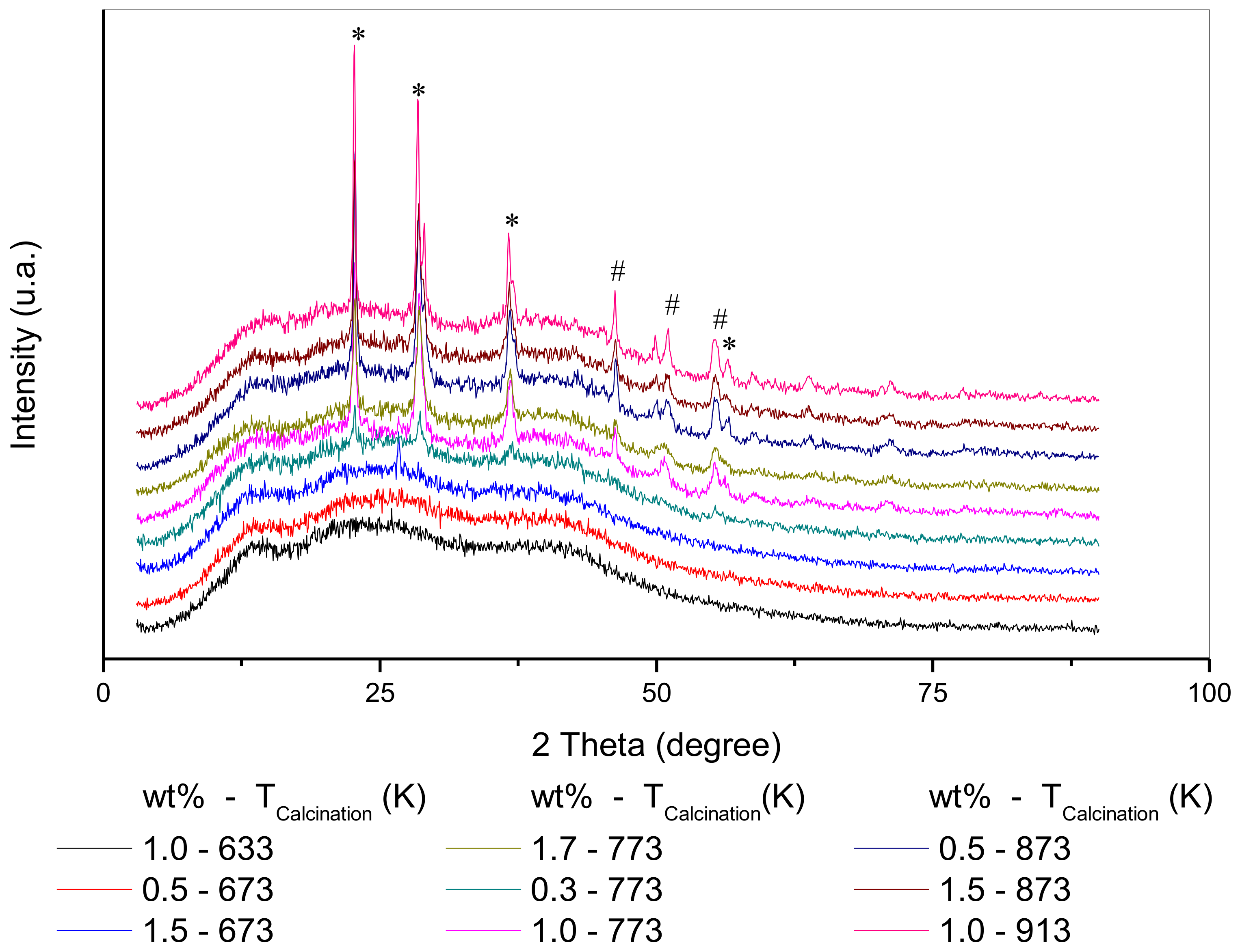
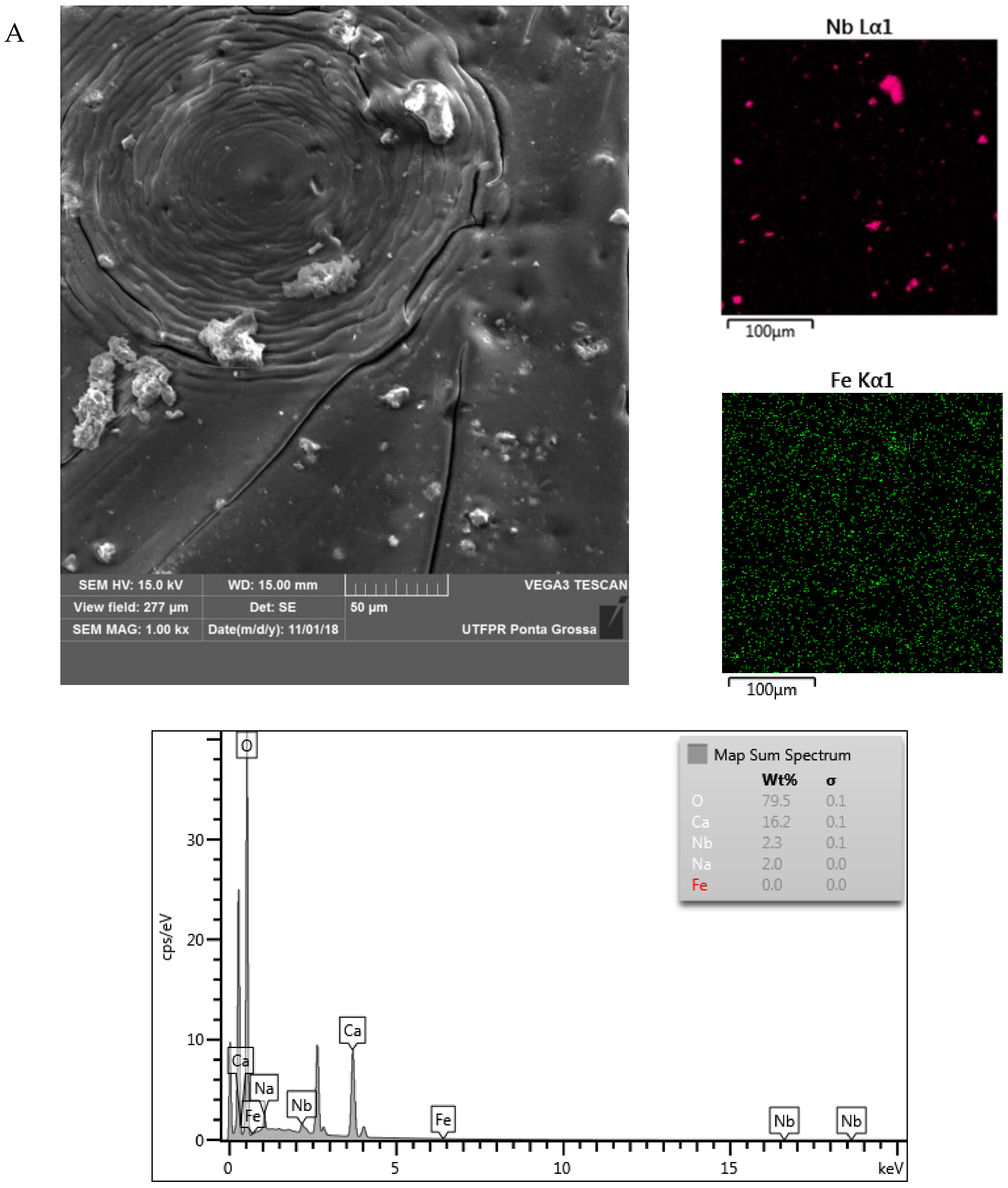
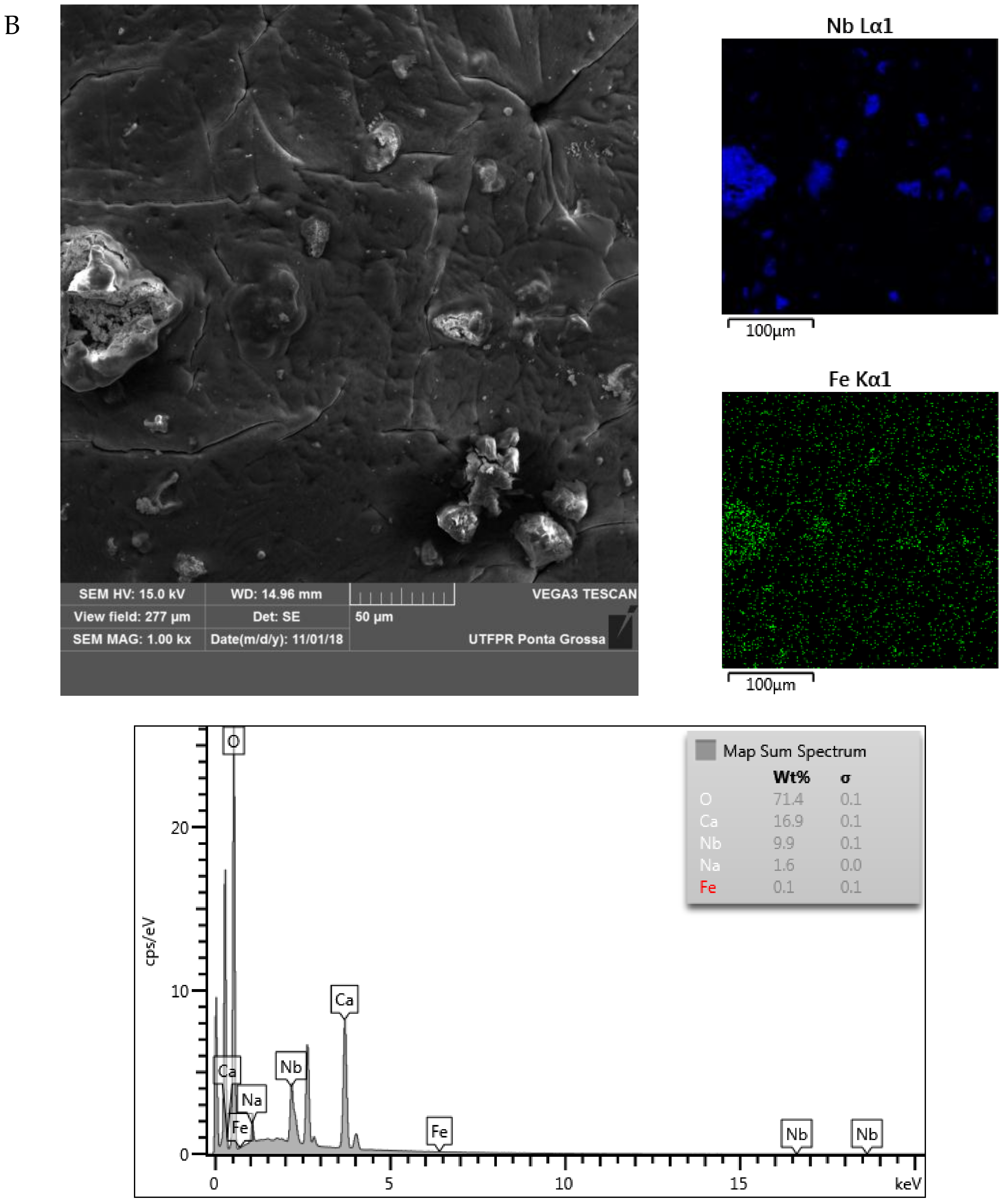
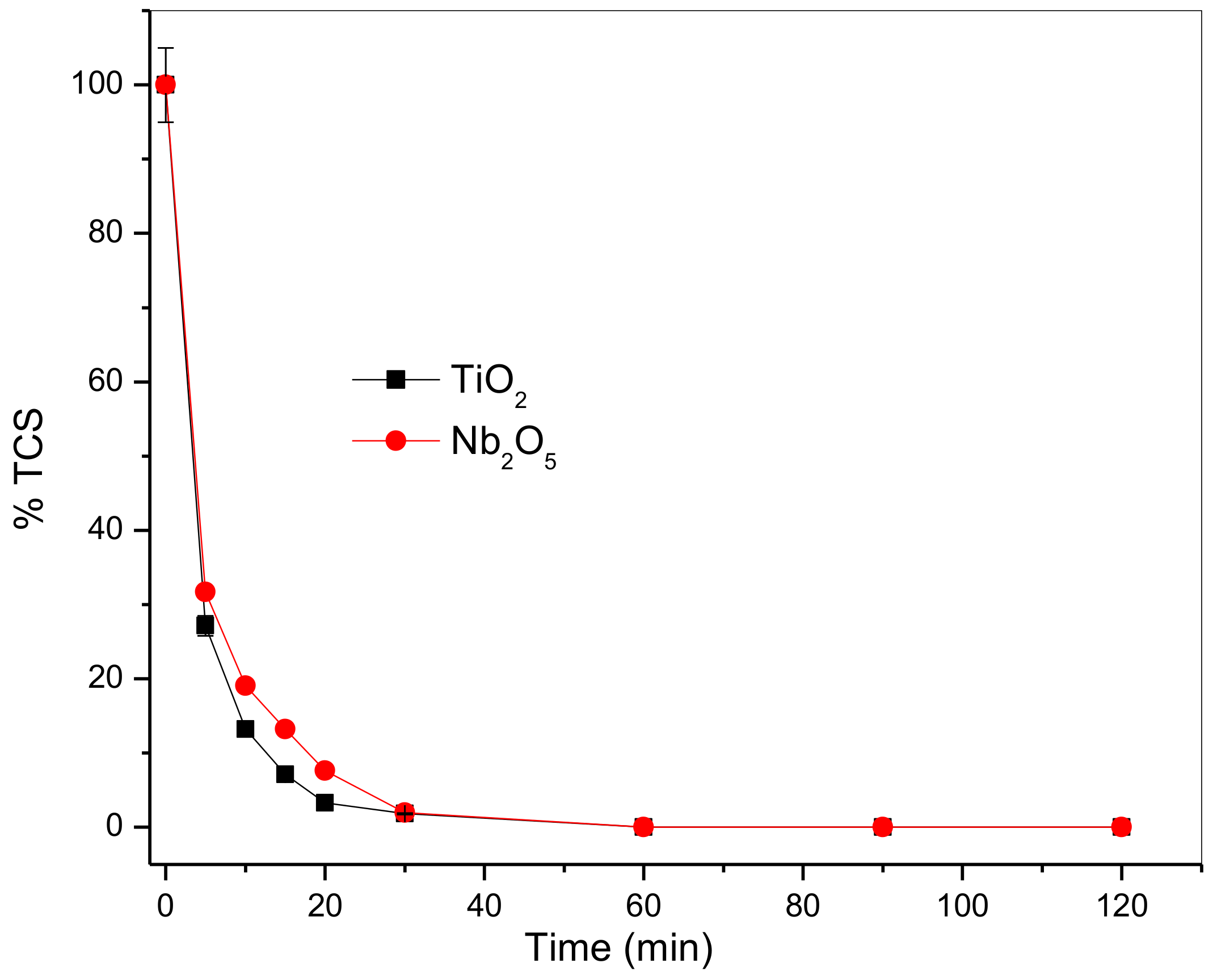
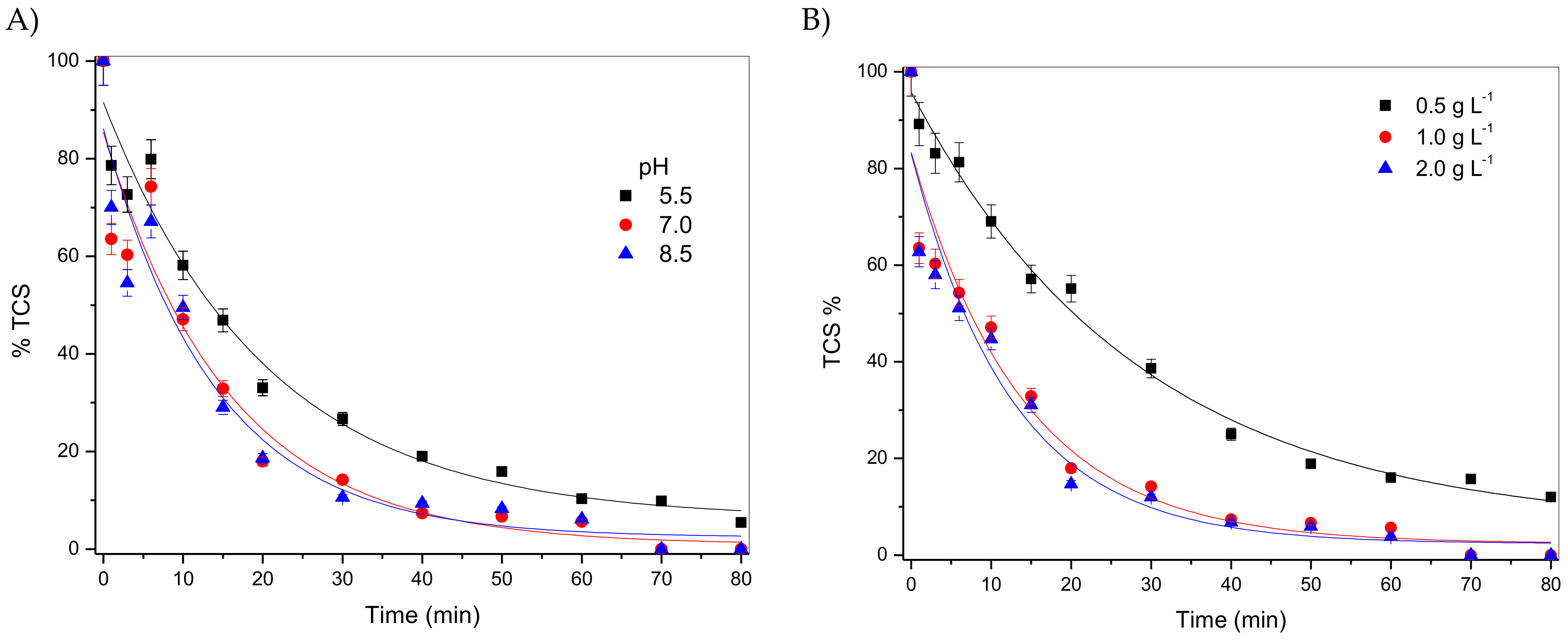
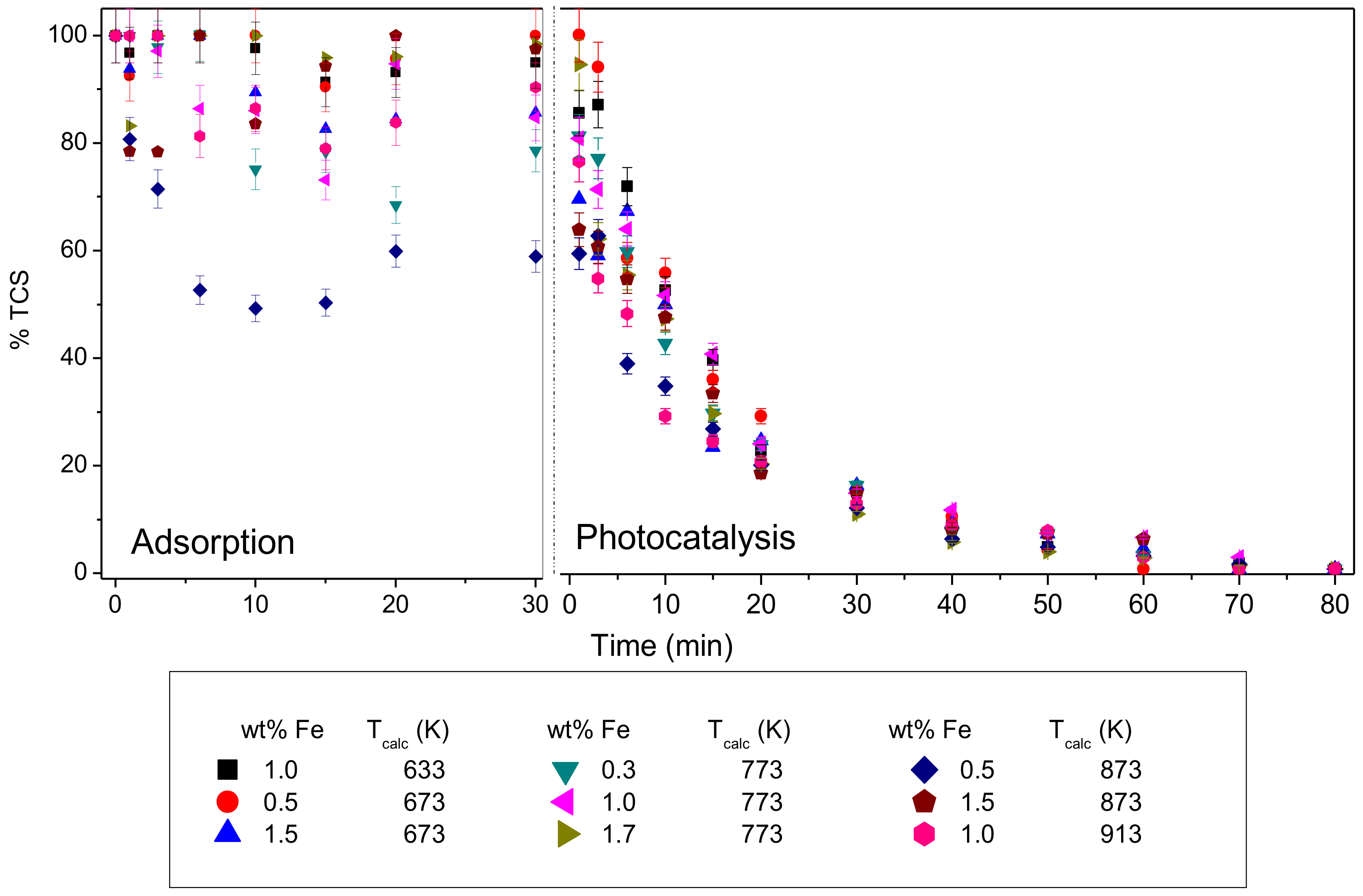

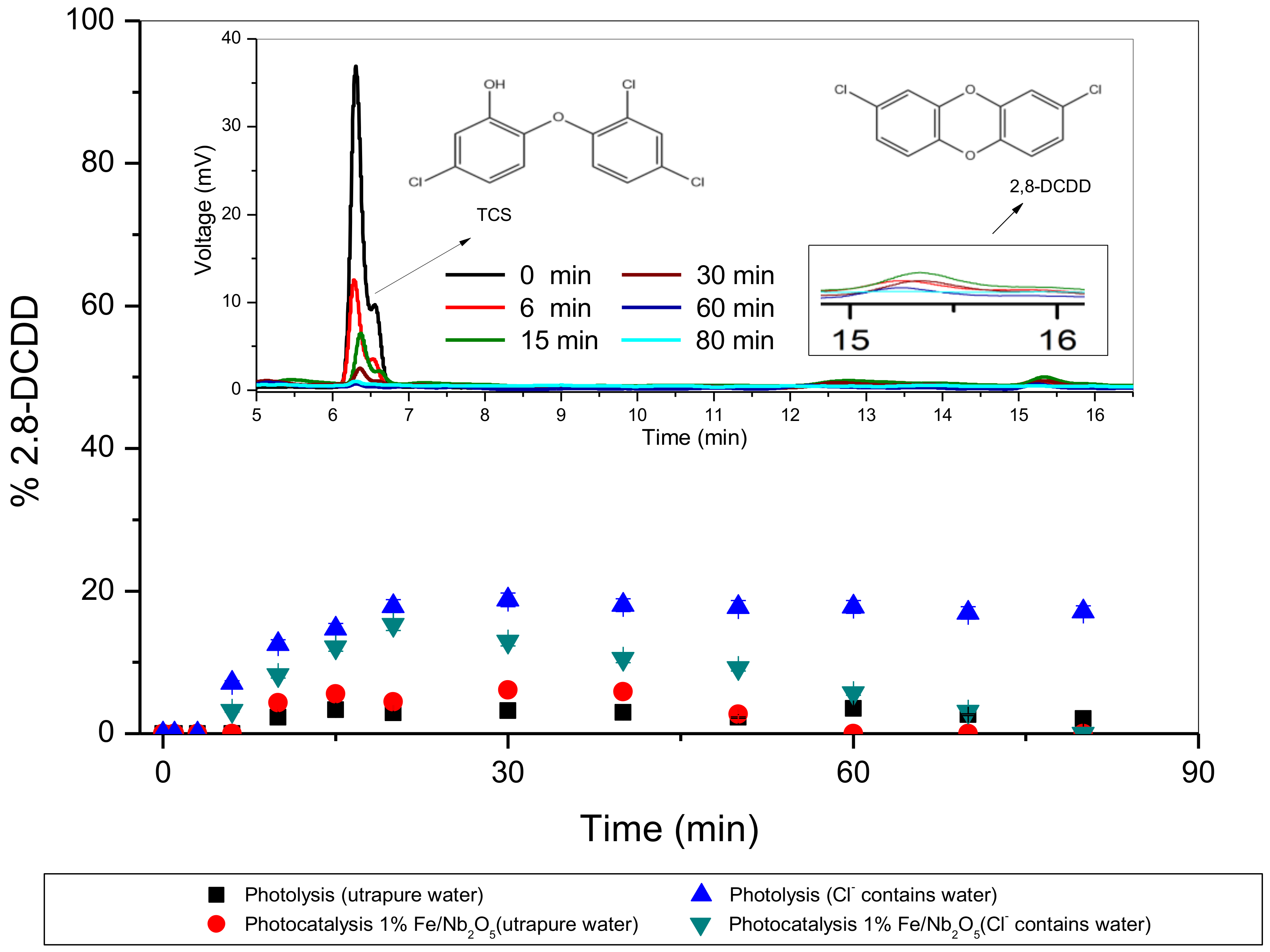
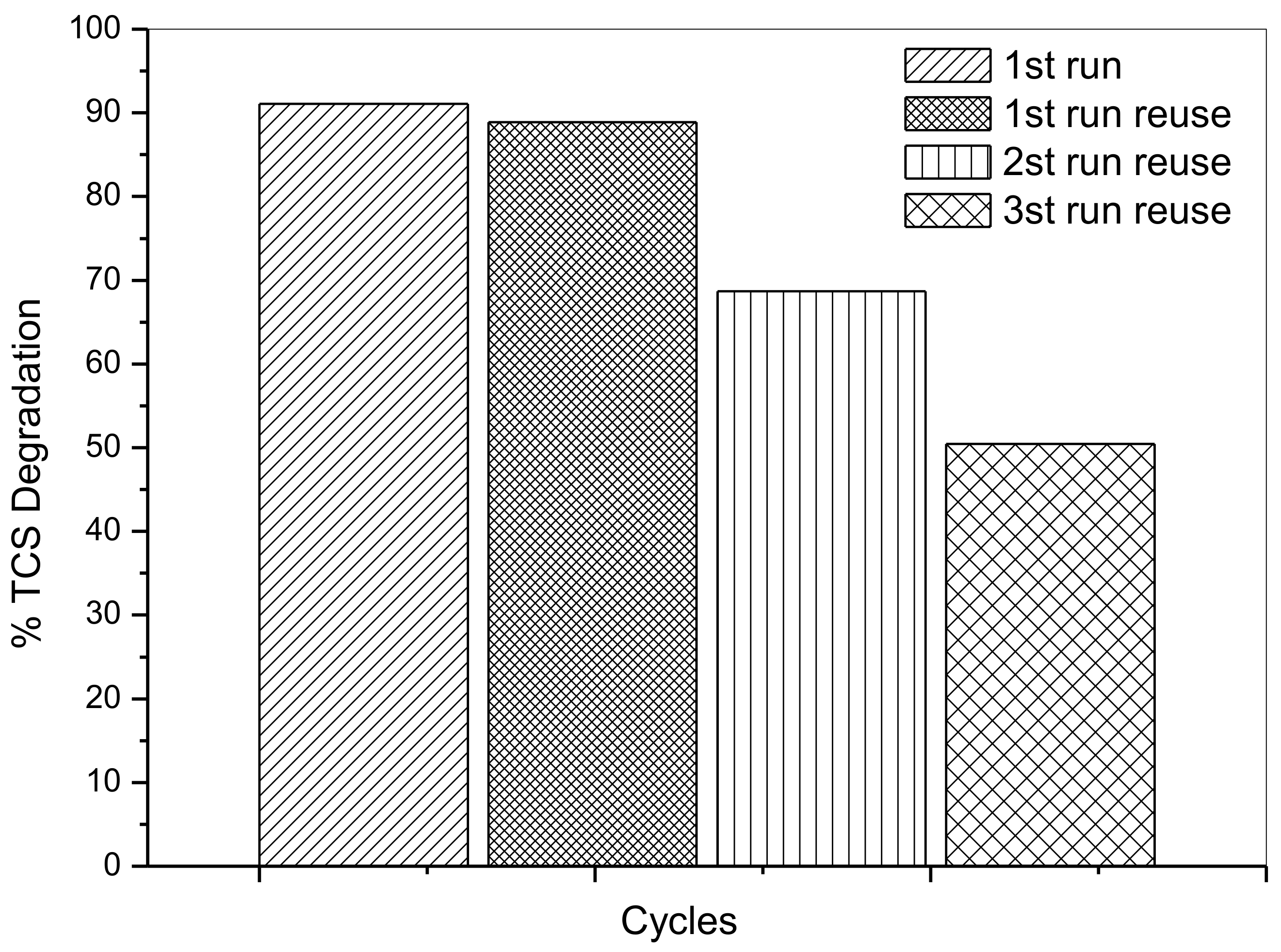
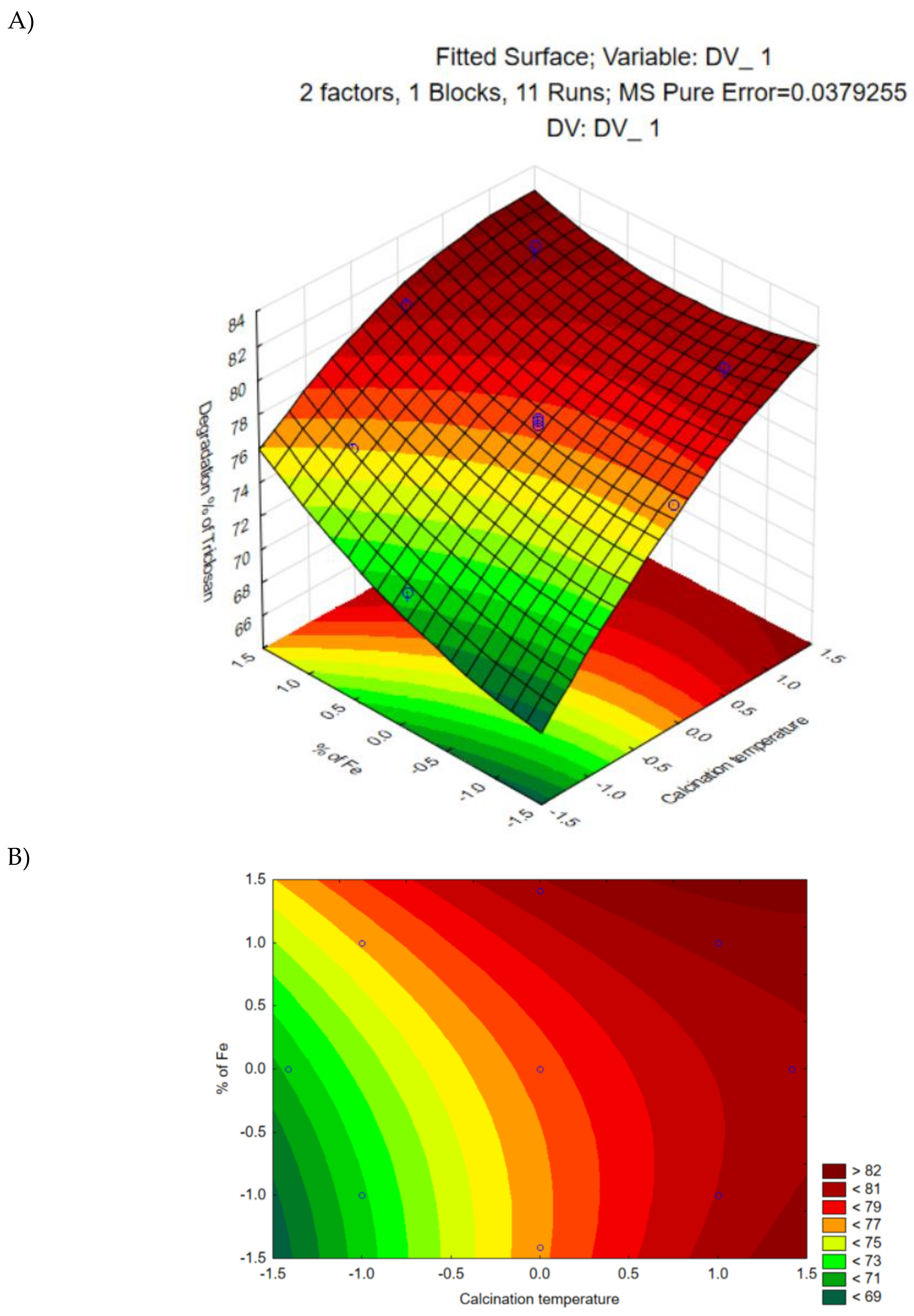
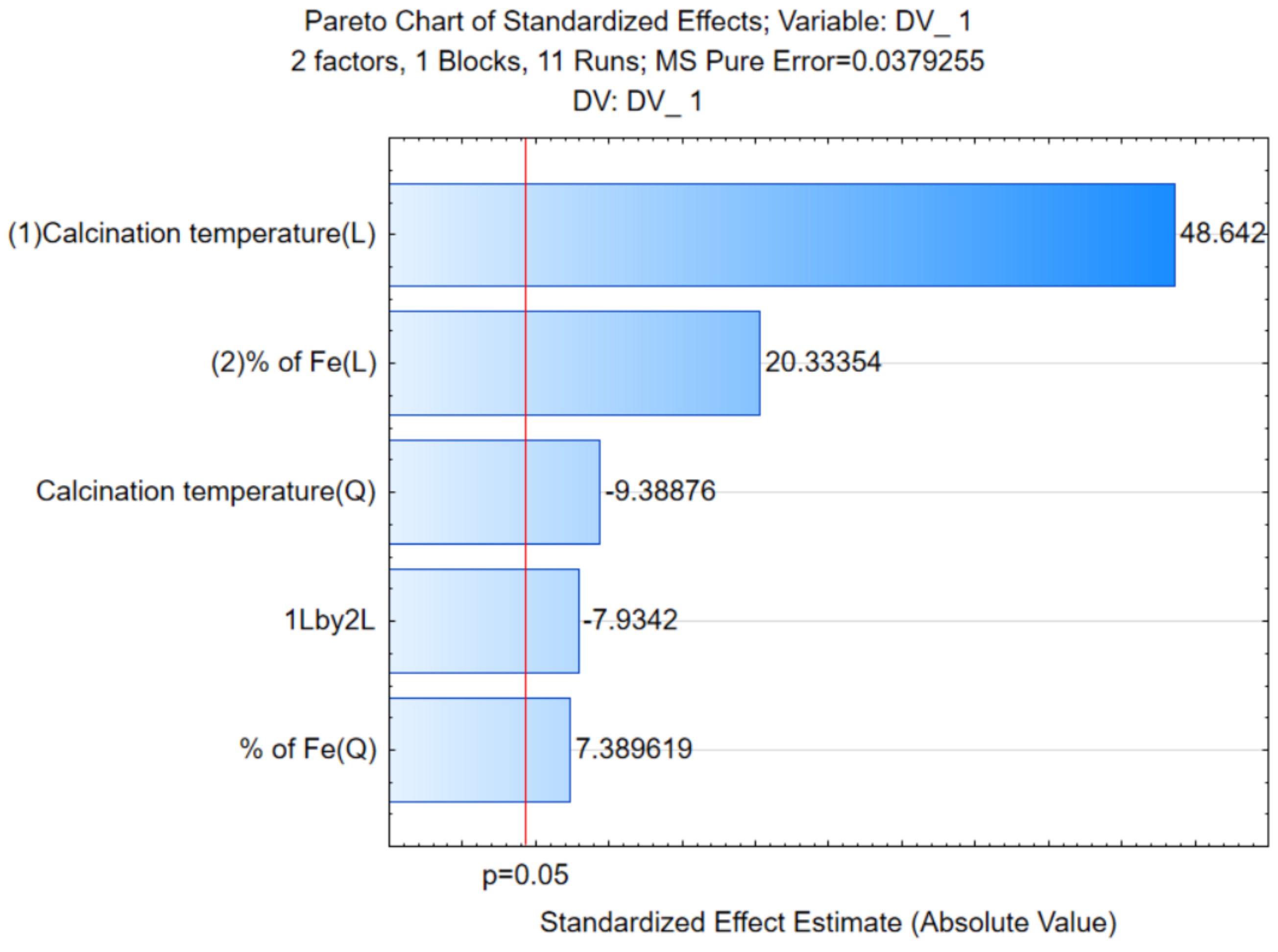
| Catalyst Fe/Nb2O5 wt %-T Calcination (K) | So (m2 g−1) | Vm (cm3 g−1) | Dm (Å) |
|---|---|---|---|
| 0.3%-773 | 49.51 | 0.00972 | 33.03 |
| 0.5%-673 | 20.26 | 0.00589 | 33.25 |
| 0.5%-873 | 148.83 | 0.00716 | 33.05 |
| 1.0%-633 | 29.55 | 0.00772 | 33.16 |
| 1.0%-773 | 149.63 | 0.00816 | 33.34 |
| 1.0%-913 | 25.42 | 0.00635 | 33.10 |
| 1.5%-673 | 64.90 | 0.00769 | 33.07 |
| 1.5%-873 | 21.24 | 0.00518 | 33.34 |
| 1.7%-773 | 43.44 | 0.01064 | 33.25 |
| Catalyst Fe/Nb2O5 wt %-TCalcination (K) | Band Gap (eV) | Absorption Threshold (nm) |
|---|---|---|
| 0.3%-773 | 3.88 | 281 |
| 0.5%-673 | 3.75 | 281 |
| 0.5%-873 | 3.94 | 279 |
| 1.0%-633 | 3.92 | 281 |
| 1.0%-773 | 3.90 | 281 |
| 1.0%-913 | 3.94 | 281 |
| 1.5%-673 | 3.28 | 292 |
| 1.5%-873 | 3.05 | 300 |
| 1.7%-773 | 3.85 | 281 |
| wt %-Tcalcination (K) | k (min−1) | t1/2 (min) | R2 |
|---|---|---|---|
| 0.3%-773 | 0.0570 | 12.16048 | 0.97926 |
| 0.5%-673 | 0.0666 | 10.40605 | 0.98392 |
| 0.5%-873 | 0.0595 | 11.64953 | 0.98398 |
| 1.0%-633 | 0.0623 | 11.12596 | 0.99583 |
| 1.0%-773 | 0.0500 | 13.86294 | 0.97886 |
| 1.0%-913 | 0.0538 | 12.89336 | 0.93194 |
| 1.5%-673 | 0.0514 | 13.48535 | 0.96524 |
| 1.5%-873 | 0.0690 | 10.04561 | 0.93221 |
| 1.7%-773 | 0.0670 | 10.34548 | 0.99106 |
| Source of Variation | Sum of Squares (SS) | Degrees of Freedom (df) | Mean Square (MS) | F | Prob > F |
|---|---|---|---|---|---|
| Regression | 115.4253 | 5 | 23.08506 | 54.66544 | 5.05 |
| Resisual | 2.1115 | 5 | 0.422297 | ||
| Lack of Fit | 2.0356 | 3 | 0.678545 | 17.891521 | 19.16 |
| Pure erro | 0.0759 | 2 | 0.037925 | ||
| Total | 117.5368 | 10 | - | - | - |
| Run | Calcination Temperature (K) | %Fe and (Coded Variable) |
|---|---|---|
| 1 | 873 (+1) | 1.5 (+1) |
| 2 | 873 (+1) | 0.5 (−1) |
| 3 | 673 (−1) | 1.5 (+1) |
| 4 | 673 (−1) | 0.5 (−1) |
| 5 | 913 (+α) | 1.0 (0) |
| 6 | 633 (−α) | 1.0 (0) |
| 7 | 773 (0) | 0.3 (−α) |
| 8 | 773 (0) | 1.7 (+α) |
| 9 | 773 (0) | 1.0 (0) |
| 10 | 773 (0) | 1.0 (0) |
| 11 | 773 (0) | 1.0 (0) |
© 2019 by the authors. Licensee MDPI, Basel, Switzerland. This article is an open access article distributed under the terms and conditions of the Creative Commons Attribution (CC BY) license (http://creativecommons.org/licenses/by/4.0/).
Share and Cite
Fidelis, M.Z.; Abreu, E.; Dos Santos, O.A.A.; Chaves, E.S.; Brackmann, R.; Dias, D.T.; Lenzi, G.G. Experimental Design and Optimization of Triclosan and 2.8-Diclorodibenzeno-p-dioxina Degradation by the Fe/Nb2O5/UV System. Catalysts 2019, 9, 343. https://doi.org/10.3390/catal9040343
Fidelis MZ, Abreu E, Dos Santos OAA, Chaves ES, Brackmann R, Dias DT, Lenzi GG. Experimental Design and Optimization of Triclosan and 2.8-Diclorodibenzeno-p-dioxina Degradation by the Fe/Nb2O5/UV System. Catalysts. 2019; 9(4):343. https://doi.org/10.3390/catal9040343
Chicago/Turabian StyleFidelis, Michel Z., Eduardo Abreu, Onélia A. A. Dos Santos, Eduardo S. Chaves, Rodrigo Brackmann, Daniele T. Dias, and Giane G. Lenzi. 2019. "Experimental Design and Optimization of Triclosan and 2.8-Diclorodibenzeno-p-dioxina Degradation by the Fe/Nb2O5/UV System" Catalysts 9, no. 4: 343. https://doi.org/10.3390/catal9040343
APA StyleFidelis, M. Z., Abreu, E., Dos Santos, O. A. A., Chaves, E. S., Brackmann, R., Dias, D. T., & Lenzi, G. G. (2019). Experimental Design and Optimization of Triclosan and 2.8-Diclorodibenzeno-p-dioxina Degradation by the Fe/Nb2O5/UV System. Catalysts, 9(4), 343. https://doi.org/10.3390/catal9040343








